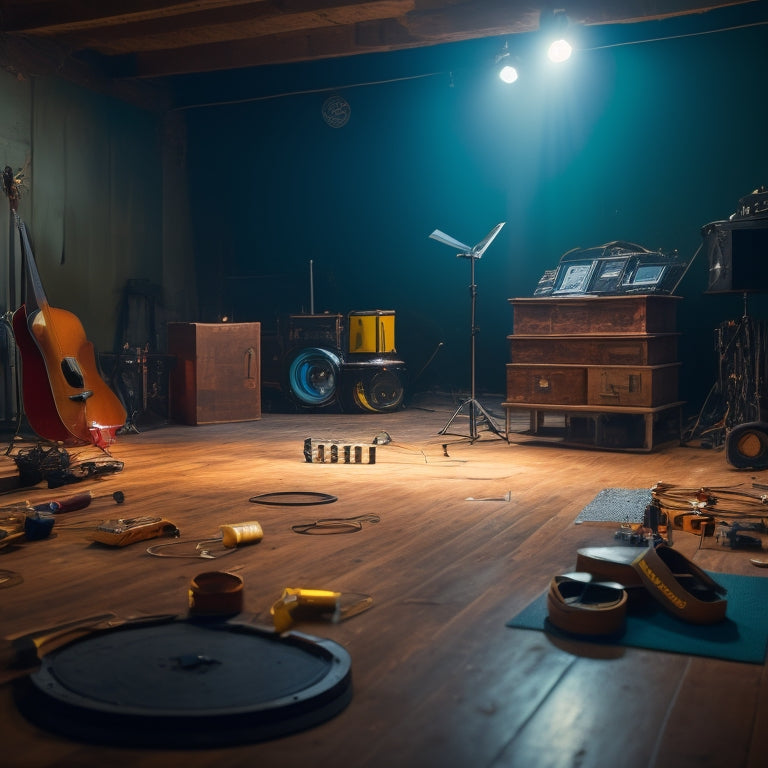
Can I Build My Own Dance Floor?
Share
You can build your own dance floor with careful planning and attention to detail. Start by evaluating your needs, considering factors like dance style, number of dancers, and budget. Choose the right flooring material, measure and mark the space accurately, and prepare the subfloor surface. Assemble the frame, install the dance floor surface, and add a non-slip coating. Don't forget to install lighting and sound systems for an immersive experience. With these steps, you'll be on your way to a professional-grade dance floor. Now, get ready to take the first step towards creating your perfect dance space, and discover the finer details that'll make it shine.
Key Takeaways
• Assess your dance floor needs, including type of dancing, number of dancers, budget, and flooring requirements to ensure a successful build.
• Choose the right flooring material, considering acoustic performance, moisture resistance, comfort, and durability, and customize to your needs.
• Measure and mark the space accurately, considering room dimensions, obstructions, and electrical outlets to ensure a seamless installation.
• Prepare the subfloor surface by inspecting, testing for moisture, cleaning, and smoothing out the surface for a stable dance floor.
• Follow manufacturer's instructions and safety guidelines when laying the dance floor frame, and consider factors like sound quality and lighting placement for an immersive experience.
Assessing Your Dance Floor Needs
Before you start building your dance floor, take a step back and assess your needs:
what kind of dancing will you be doing, how many people will be using the floor, and what's your budget for the project? Understanding your requirements will help you create a functional and efficient space.
Consider the type of dance you'll be doing most often - will it be high-energy hip hop or elegant ballet? This will impact the type of flooring you need.
Also, think about the number of dancers who'll be using the floor at once, as this will influence the space utilization.
Don't forget to factor in budget constraints - you don't want to break the bank on a floor that's beyond your means.
Choosing the Right Flooring Material
Now that you have a clear understanding of your dance floor needs, it's time to select the perfect flooring material that will provide the necessary support, comfort, and durability for your dancing style. When choosing the right flooring material, consider factors such as acoustic performance, moisture resistance, and durability. Here's a comparison of popular flooring materials:
| Material | Acoustic Performance | Moisture Resistance |
|---|---|---|
| Hardwood | Excellent | Low |
| Laminate | Good | High |
| Vinyl | Fair | Excellent |
| Ceramic Tile | Poor | Excellent |
Consider your specific needs and preferences to choose the best material for your dance floor. Will you prioritize acoustic performance or moisture resistance? The appropriate flooring material will ensure a comfortable and durable dancing experience.
Measuring and Marking the Space
You're ready to bring your dance floor vision to life, and it starts by accurately measuring and marking the space where your flooring will be installed. Take out your tape measure and record the room dimensions, considering any space constraints that might impact your design.
Measure the length, width, and any obstructions, such as pillars or uneven walls. Make note of any electrical outlets, vents, or other features that might affect your flooring layout. Use a pencil to mark the space, visualizing where your dance floor will sit within the room.
This critical step guarantees a seamless installation process, so take your time and get it right. With precise measurements, you'll be well on your way to creating a stunning dance floor that complements your space.
Preparing the Subfloor Surface
With your dance floor design taking shape, it's essential to make sure the subfloor surface is properly prepared to support your new floor, and that means addressing any imperfections or unevenness that could compromise the installation. You'll need to conduct a thorough subfloor inspection to identify any cracks, unevenness, or damage.
| Task | Description |
|---|---|
| Subfloor inspection | Check for cracks, unevenness, or damage |
| Moisture testing | Make sure the subfloor is dry and free of moisture |
| Cleaning | Remove dirt, dust, and debris from the subfloor |
| Filling gaps | Fill any cracks or gaps with a self-leveling compound |
| Sanding | Smooth out the subfloor surface |
Laying the Dance Floor Frame
Now that you've prepared your subfloor surface, it's time to focus on building the frame that will support your dance floor.
You'll need to decide on the type of material to use for the frame, considering factors like durability, cost, and ease of installation.
As you assemble the frame, make sure it's level, secure, and perfectly aligned to provide a solid foundation for your dance floor.
Frame Material Options
Two primary frame material options are available for building your dance floor: wood and metal, each offering distinct advantages and challenges. Wood frames provide a rustic, natural look and can be sourced sustainably, supporting eco-friendly construction. Metal frames, on the other hand, offer strength and durability, making them ideal for high-traffic areas.
| Material | Advantages | Challenges |
|---|---|---|
| Wood | Rustic aesthetics, sustainable frames | Prone to warping, requires regular maintenance |
| Metal | Strength, durability | Cold, industrial look, noisy |
| Hybrid | Combines benefits of wood and metal | Higher cost, complex installation |
| Aluminum | Lightweight, corrosion-resistant | Expensive, may not support heavy loads |
| Steel | Strong, affordable | Heavy, prone to rust |
Choose the material that best fits your vision, budget, and dance floor needs.
Assembling the Frame
Once you've chosen your frame material, start assembling the frame by laying out the dance floor's perimeter, making sure it's square and level to prevent future installation headaches.
You'll want to ponder the frame style that suits your dance floor's design. Popular frame styles include fixed, folding, and modular frames. Each has its advantages, so choose wisely.
Next, focus on the corner types. You can opt for mitered, butt-jointed, or reinforced corners, depending on the frame style and material. Make sure to follow the manufacturer's instructions or your design plan to guarantee a sturdy and reliable frame.
Installing the Dance Floor Surface
Now it's time to bring your dance floor to life with the perfect surface!
You'll need to choose from a variety of flooring material options, considering factors like durability, maintenance, and aesthetics.
As you prepare to install your chosen surface, think about the dance floor layout that will best suit your needs and style.
Flooring Material Options
You'll have a wide range of flooring material options to choose from, each with its own unique characteristics, benefits, and considerations, when installing the dance floor surface.
As you explore the latest flooring trends, consider sustainable options that align with your values and budget. You might opt for eco-friendly materials like reclaimed wood, bamboo, or cork, which aren't only environmentally friendly but also offer a unique aesthetic.
Alternatively, you could choose durable and low-maintenance options like vinyl or laminate flooring. Whatever your preference, it's crucial to consider factors like durability, slip resistance, and sound absorption to make sure your dance floor meets your needs.
Dance Floor Layout
With your flooring material selected, it's time to plan the dance floor layout, carefully considering the room's dimensions, traffic flow, and your personal preferences to create an ideal dance floor surface.
You're creating a space that's both functional and inviting, so think about how you'll move around the dance space. Will you be spinning, leaping, or swaying to the music? Consider the flow of traffic and leave enough room for comfortable movement.
Think about floor patterns, too - will you opt for a classic square, a dynamic diagonal, or a unique design? By planning your dance floor layout thoughtfully, you'll create a space that's both beautiful and functional, allowing you to express yourself freely and fully.
Adding a Non-Slip Coating
Safety takes center stage when you apply a non-slip coating to your dance floor, ensuring that every step, spin, and leap is executed with confidence and poise. You'll want to prioritize slip resistance, as it's vital for preventing accidents and injuries.
When choosing a coating type, consider epoxy, polyurethane, or acrylic options. Each has its benefits, so research and select the one that best suits your dance floor's specific needs. Remember to follow the manufacturer's instructions for application and drying times to guarantee a durable, long-lasting finish.
Installing Lighting and Sound
Transform your dance floor into a vibrant atmosphere by strategically placing lights that accentuate the rhythm and energy of your movements, while simultaneously setting up a sound system that resonates with crystal-clear quality.
You'll want to carefully contemplate Lighting Placement, taking into account the size and shape of your dance floor. Install lights that can be adjusted to different angles and intensities to create an immersive experience.
For an ideal Sound Waves experience, position your speakers to make sure that the sound is evenly distributed throughout the dance floor. Don't forget to invest in a high-quality sound system that can handle the energy of your dance sessions.
With the right lighting and sound, you'll be prepared to release your inner dancer and let the music move you!
Final Touches and Safety Checks
You've set the stage with enchanting lights and immersive sound, now it's time to add the finishing touches and make sure your dance floor is a safe haven for self-expression. As you put the final pieces in place, don't forget to prioritize safety. Hire Floor Inspectors to conduct thorough Safety Audits, ensuring your dance floor meets the highest standards.
| Safety Checklist | Completed? |
|---|---|
| Clear exits and emergency routes | |
| Secure electrical equipment | |
| Non-slip flooring and handrails | |
| Fire extinguishers and first aid kits |
Frequently Asked Questions
Can I Build a Dance Floor on a Sloping or Uneven Surface?
"Sloping surfaces, don't sabotage your spin! You can conquer uneven terrain by implementing slope correction measures and meeting leveling requirements, ensuring a sturdy foundation for your dance floor, where freedom of movement reigns supreme."
How Do I Ensure My Dance Floor Is Accessible for People With Disabilities?
When establishing an inclusive space, you'll want to guarantee wheelchair accessibility by incorporating a ramp with a gentle slope, meeting ADA standards, to secure equal freedom for all to dance and enjoy the celebration!
What Are the Benefits of Using a Sprung Dance Floor System?
"As you step onto the dance floor, remember the mythical Nike's winged feet, swift and free. With a sprung dance floor system, you'll experience shock absorption, energy return, and injury prevention, while enjoying sound reduction - liberating your moves, and your spirit!"
Can I Build a Dance Floor Outdoors or in an Area With High Humidity?
'When building a dance floor outdoors or in humid areas, you'll want to prioritize weather resistance and moisture protection to guarantee durability. Choose materials and coatings that can withstand the elements, and consider a waterproofing membrane for added security.'
How Do I Properly Clean and Maintain My Dance Floor to Extend Its Lifespan?
"As you twirl across your dance floor, remember to give it some TLC! You'll be dancing your way to a longer lifespan with daily sweeping and regular polishing - your floor (and your feet) will thank you!"
Related Posts
-

7 Ways Online Courses Boost Dance Business Success
By offering online courses, you can revolutionize your dance business, boosting visibility, credibility, and profitab...
-

Long-Lasting Dance Makeup: Tips for a Flawless Finish
To achieve a long-lasting dance makeup look, start by preparing your skin through cleansing, moisturizing, and exfoli...
-

Innovative Therapy: Dance Movement's Healing Power
Dance movement therapy is a creative and evidence-based approach that harnesses the transformative power of movement ...


